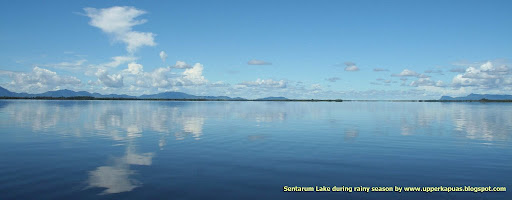
Children are playing in the wooden path along the huts. That path is the only place for kids’ playground in that hamlet. They do not have another place as the hamlet is surrounded by water and swampy forest. In the daytime when sun shines heatly, those children play on an shed, enjoy the windy air in Sentarum Lake.

It’s name Lubuk Liuk, a small village in Sentarum Lake watery. It’s 20 minutes by speed boat (with 60PK machine), from Lanjak, the capital of Batang Lupar sub-district. It encompasses tens of small wooden houses. It’s occupied by fishermen’s family during the dry season.
This hamlet is empty during the wet season (rainy season). The innate atmosphere of this community has become an interesting point for visitor.
Along with its simplicity, for many times Lubuk Liuk became a spot for documentary film shootings, from national and foreign TV stations.

With 132,000 hectares widely, Sentarum lake is the source of life for fishermen. Many kind of fish could be found here, in particular fresh water fish species.
Hasan Basri, head of the Lubuk Liuk hamlet, their income has decrease since Sentarum Lake got a status of national park. The authority of national park forbids fishermen using certain traditional fishing tools which can be harm the lake’s inhabitant.
Working as a fisherman on the lake Sentarum, according to Hasan Basri, does not give satisfactory financial outcomes. The high price of fuel for their boats, is one of the reasons, while the selling price the fish is uncomparable. The price of fish in lake is very lower than in town. Therefore more people choose to make salted fish and smoked fish as those are higher in price than fresh fish.

Women and children will greet every boat that came as they belief it brings many fishes. In dray season they would get plenty, and often they catch expensive fish, for instance jelawat fish and betutu fish.
When the fish arrived, the women took role, cleaned the chosen fishes for their lunch and dinner. In this picture, a wife of fisherman was cleaning the jelawat fish. In town, this fish could reach a price of Rp. 80,000,- per kilogram.

Unlike village in general, Lubuk Liuk is a seasonal hamlet. Fishermen only stay there during the dry season as it’s a harvest season for fishing in the lake. It’s from the end of April to the end of July. During school holiday (June-July) the hamlet will be more crowded as fishermen also bring their children. This time is a right time for tourist to visit. A place to stay overnight is provided by local people.
In the rainy season or at the season when watery is in high level, the hamlet’s residents return to their initial village. Most of them are from Selimbau sub-district. They work in agricultural field, like farming, gardening and keeping livestock (cows, chickens), in their home village.


